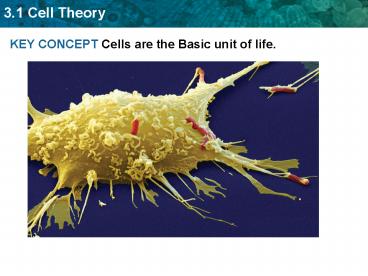KEY CONCEPT Cells are the Basic unit of life. - PowerPoint PPT Presentation
1 / 17
Title:
KEY CONCEPT Cells are the Basic unit of life.
Description:
KEY CONCEPT Cells are the Basic unit of life. The cell theory grew out of the work of many scientists and improvements in the microscope. The cell theory grew out of ... – PowerPoint PPT presentation
Number of Views:134
Avg rating:3.0/5.0
Title: KEY CONCEPT Cells are the Basic unit of life.
1
- KEY CONCEPT Cells are the Basic unit of life.
2
- The cell theory grew out of the work of many
scientists and improvements in the microscope.
- Many scientists contributed to the cell theory.
3
- The cell theory grew out of the work of many
scientists and improvements in the microscope. - Many scientists contributed to the cell theory.
- More was learned about cells
as microscopes
improved.
4
- The cell theory grew out of the work of many
scientists and improvements in the microscope. - Many scientists contributed to the cell theory.
- More was learned about cells
as microscopes
improved. - The cell theory is a unifying
concept of biology.
5
- Early studies led to the development of the cell
theory.
- The Cell theory has three principles.
- All organisms are made of cells.
6
- Early studies led to the development of the cell
theory.
- The Cell theory has three principles.
- All organisms are made of cells.
- All existing cells are produced by other living
cells.
7
- Early studies led to the development of the cell
theory. - The Cell theory has three principles.
- All organisms are made of cells.
- All existing cells are produced by other living
cells. - The cell is the most basic unit of life.
8
- Prokaryotic cells lack a nucleus and most
internal structures of eukaryotic cells. - All cells share certain characteristics.
9
- Prokaryotic cells lack a nucleus and most
internal structures of eukaryotic cells. - All cells share certain characteristics.
- Cells tend to be microscopic.
10
- Prokaryotic cells lack a nucleus and most
internal structures of eukaryotic cells. - All cells share certain characteristics.
- Cells tend to be microscopic.
- All cells are enclosed
by a membrane.
11
- Prokaryotic and eukaryotic cells.
- All cells share certain characteristics.
- Cells tend to be microscopic.
- All cells are enclosed
by a membrane. - All cells are filled with
cytoplasm.
12
- There are two cell types eukaryotic cells and
prokaryotic cells.
13
- There are two cell types eukaryotic cells and
prokaryotic cells.
14
- There are two cell types eukaryotic cells and
prokaryotic cells.
15
- There are two cell types eukaryotic cells and
prokaryotic cells. - Prokaryote means
- first cells.
- Eukaryote means
- new cells.
16
- There are two cell types eukaryotic cells and
prokaryotic cells.
17
- Read the section in 3.1 detailing the two types
of cells prokaryotes and eukaryotes - Page 72 - Make a poster explaining their similarities and
differences. - Include
- Color
- Structures
- Examples
- Write a sentence explaining prokaryotes and
eukaryotes - Focus on the advances of the Eukaryotes (ie
new and improved!)































